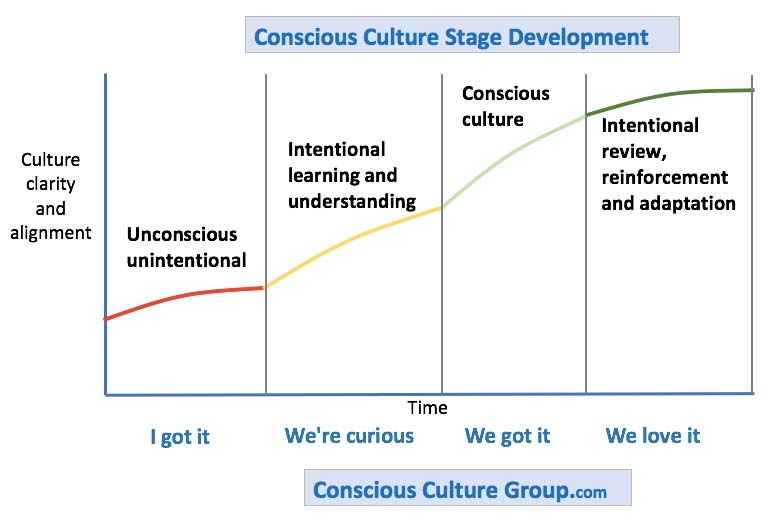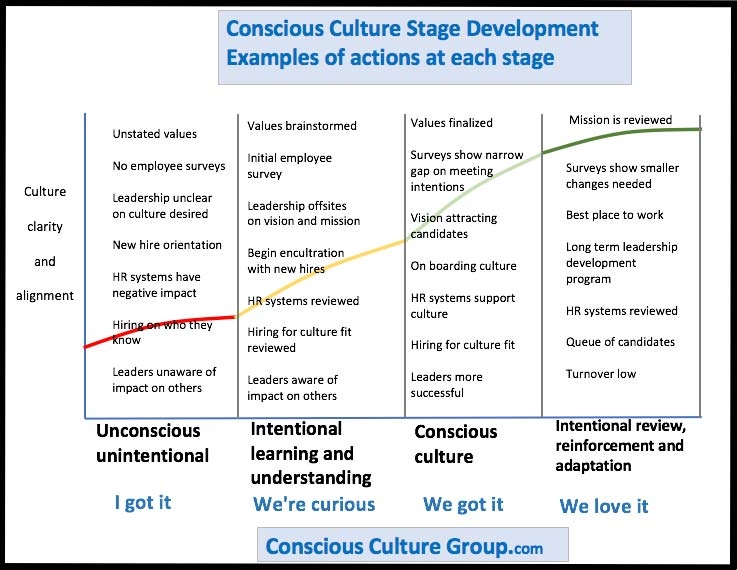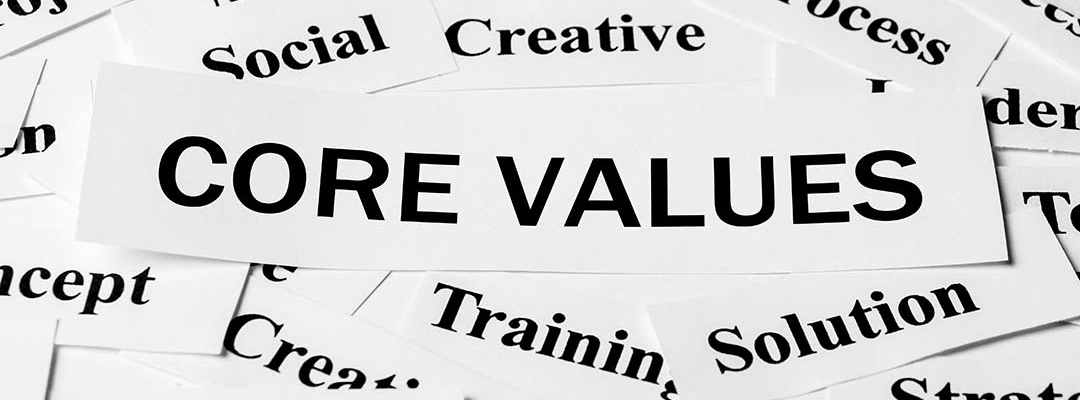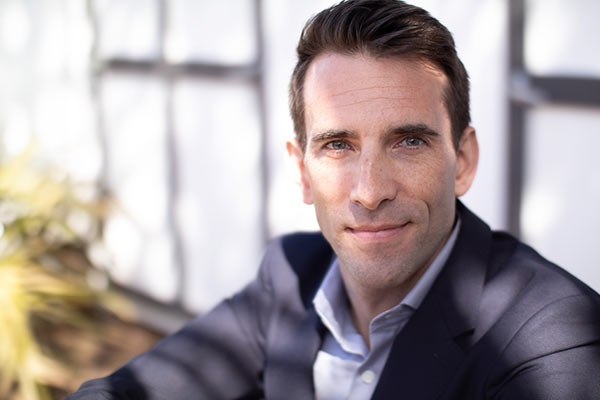While recently having blood drawn for a medical screen, the attendant asked what I do for a living. I shared with her that I was a company culture consultant and the founder of the Conscious Culture Group. She didn’t understand what company culture was and asked about it.

We discussed her work, her work environment, her manager and the leaders in her organization. After talking about other culture-related topics, her response was, "Oh, I understand what culture is. They want it to be the things on the back of this card [company values], but the truth is that this card is useless. We don’t follow any of these values. We really have no culture."
Unfortunately, I hear that a lot. There is a large misalignment between what an organization's leaders say they want and what employees actually experience. Most companies are operating in an "unconscious unintentional" culture stage.
Wells Fargo is an example. They created values that included "doing what's right for customers," yet they veered off in the wrong direction with "widespread illegal" sales practices that included opening as many as 2 million accounts without customer permission. This led to a $185 million fine and many lost clients.
Why? The misaligned HR system of compensation drove the culture.
"We had to meet sales goals every day or I could get written up," according to one employee. Another employee stated, "The quotas were simply a way to keep my job, not to earn any substantial bonus or commission."
These are examples of significant misalignment wherein the employee experience—which is what really matters—runs counter to the intentions of the leaders.
Four Stages of a Conscious Culture
As the founder and chief consultant of the Conscious Culture Group, I am asked how organizations can move forward toward a conscious intentional culture. There are four stages:
- Unconscious unintentional culture
- Intentional learning and understanding
- Conscious culture
- Intentional review, reinforcement and adaption

Let's examine each stage and indicators for each stage.
1. Unconscious Unintentional Culture
The example of the medical attendant perfectly describes an unconscious unintentional culture. The leaders believe that they have built an organizational culture, but the results—based on that employee's experience—show that there is not a connection between what the leaders declared the culture to be and what the culture actually is. Many organizations are focused on making their operation more efficient/effective without delving into culture.
Every organization—whether a startup with three employees or a 50-year-old company that has not moved with the times—has a culture. Often when organizations are small, the culture is defined by the founder's personality and values. Those founders often hire staff like themselves, at which point the culture is built with stated and unstated norms, practices and behaviors.
This stage is best defined as "I got it," because it reflects each employee's own personal journey and interpretation of the culture. Employee experiences can vary from manager to manager and location to location. Managers manage to their own styles rather than managing to the company culture.
At this stage, you will find:
- Leadership's lack of clarity for a unique culture
- Vision and mission are nonexistent or, if they are written, not unique
- Unstated values and/or values that are not consistent with the employee experience
- Little or no surveying of employees
- New-hire orientations are only about completing paperwork
- Manager training on the basics of managing are not tied to the unique culture
- Little attention to the impact HR systems have on the culture
- Hiring people whom managers know personally rather than for culture fit
- Little or no employment branding exists on the company website
- Little, if any, exit-interview process; people just leave
- Little or no cultural training for employees
2. Intentional Learning and Understanding
This stage often begins the journey to understanding that culture matters but there has not been a focused effort. Management often starts to understand that culture can account for up to half of the difference in operating profit between two organizations in the same business.
It is the "We're curious" stage, as the culture moves from an individual sense to a broader organizational purposefulness using diagnostics. Many times this step involves external culture consultants to help the organization grow in its understanding of the impact this effort will require and the resources necessary for success.
With the knowledge that culture matters, leaders begin to understand the elements that comprise culture and begin referencing the Conscious Culture model. They understand that building an intentional culture takes time: It is more like steering a big ship rather than turning a speed boat.
They create a thoughtful plan that determines the existing behaviors and the required behaviors. It is often determined that the best way to begin is with a culture survey assessment or with leadership insights and cohesion. Leadership must be supportive of any assessments, ready to move forward using the knowledge from these assessment. Employees must be fully knowledgeable about how the process works and be willing to be part of the effort. Employee trust can begin to be built here.
At this stage, you will find:
- Initial benchmarks through surveys are launched that help leadership understand employee experience
- Leaders look internally at their unintentional impact on others and want to improve their impact through 360-degree feedback and executive coaching
- Leaders hold leadership team offsite meetings to establish their unique vision and mission
- Communication of findings are shared using multiple forums: email, memos, face to face, department meetings, all-hands meetings, etc.
- Values and behaviors are brainstormed with the help of employees
- New-hire orientations are enhanced, ensuring enculturation into the organization's intentional culture
- Assessments are initiated that determine the skills needed for managers to be successful in their unique culture
- HR systems are reviewed to better understand those that are supportive of the culture and those that encourage behavior different from the intended culture
- Organizations choose to use culture fit as a key factor for hiring selection
- Relevant training on culture fit is researched
- Employment branding that shares the internal culture with the outside world is researched
- Exit interviews are started to understand why employees leave.
3. Conscious Culture
This stage occurs when there is alignment of leader intentions with the employee experience. One way of determining if alignment exists is to inquire and listen to new hires. In a conscious culture, new hires will tell you that they understood the culture before they joined the company and that the culture is actually exactly what they were told it would be. New hires continually seek to understand ways of behaving in a company and therefore can tell you if there are disconnects.
While stage two is about learning and understanding gaps, stage three bears fruit from all of the efforts. Employees feel the desire to be successful, and self-motivation creates results. Employees are aligned to the vision, know the values and expected behaviors, and are engaged. Employee referrals are restricted to those who fit the culture.
Managers recognize employees with a tie into the values and culture. The entire company has the sense that "We got it," and the ship is well on its way to turning in the right direction. Everyone is feeling it.
At this stage, you will find:
- The vision is attracting candidates who want to be part of the organization because the higher purpose is larger than themselves
- The mission clearly expresses to employees and clients how the organization will move toward the vision
- The values are well defined and tied to behaviors; employees are coached and evaluated upon the values they exhibit each day
- The conscious-culture survey is trusted by all employees, with very high participation rates; there are only narrow gaps between the leadership’s desires and the employee experience
- A culture leadership team is formed to understand the "truth" of the employee experience
- Communication is key: Employees at all levels must have full understanding of where the organization is headed, why it is headed there, what will be required and related time tables. Consistent communication of findings and plans are shared using multiple forums: email, memos, face to face, department meetings, all hands meetings, etc.
- Leaders are welcoming 360-degree assessment and executive coaching so they can become better leaders. Leaders may share issues they are working on and solicit feedback on ways they can improve upon their behaviors and methods.
- Significant on-boarding (e.g., two weeks) allows the new hire to fully understand the culture and the organization
- Managers are trained on the behaviors expected and are given regular feedback on their performance with regard to these expectations. Training can be initiated with executive leadership participating as facilitators and coaches, and by finding necessary ways to support this effort throughout the organization.
- There is a long-term leadership development program that teaches top-level leaders the competencies required to be a successful leader in the unique culture.
- All HR systems are aligned to the culture; when a new policy is needed, culture is part of the conversation.
- For hiring, culture fit is at least 50 percent of the selection criteria for hire selections. Managers are well trained to screen for both culture and technical fit. The first question in any hiring is, "Do they fit into who we are? Will they add value to our culture? Can they function here?"
- The employment brand on the company's website shares the amazing employee experience, including videos of employees and an explanation of the company culture.
4. Intentional Review, Reinforcement and Adaption
This becomes the easiest stage and most fun of the four because the work environment is engaging and purposeful with employees who want to be part of the company. Good friendships are developed at work. Friends and families become proud of the employee because they have found a job that is a great place to work.
This is why it is called the "We love it" stage.
Stage four is the continuous-improvement phase, as well as the point to adapt to a new CEO, industry environment, technology breakthrough or other unplanned change. Creating a culture of innovation is easier at this stage because trust is high and purpose is known.
At this stage, you will find:
- The mission being revised as the company, industry and technology changes.
- Culture surveys become a regular part of the fabric, with positive results coming from each survey; opportunities for improvement are reviewed and plans put in place to move forward in the process.
- The culture leadership team (with a key role of communication) is a coveted committee with a waiting list
- HR systems are regularly reviewed and revised.
- There is a queue of candidates for each job opening.
- Turnover is low, and those not meeting expectations are initially coached for success or coached out the door.
- There is great interest in being part of the long-term leadership development program
- Newer managers are trained by "expert internal managers" on the skills needed to be an effective manager in the company culture.
- Exit interviews become something employees want when they exit because they know the intention is to use that information to improve culture.
- Culture is considered when acquiring other companies.
- Turnover is low after acquisition as the enculturation of the new company’s employees has been effectively implemented early on.

Creating a conscious culture is neither easy nor fast. It takes time and a plan to begin building. Every organization starts somewhere.
At the Conscious Culture Group, we love to work with leaders on creating the map that outperforms competitors by helping to develop their own unique and intentional culture.
Learn more about how you can start or advance your company’s conscious culture with the new Building a Conscious Company Culture, starting Oct. 28.



